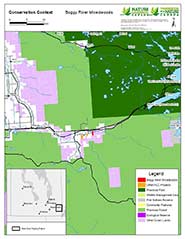Giving back to the land
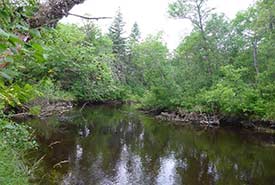
Boggy River in the summer (Photo by NCC)
One of the most rewarding parts of my job as natural area manager with the Nature Conservancy of Canada (NCC) is working with landowners who want to donate their land to us. It is humbling to know that they support NCC’s vision — enough so to entrust NCC with their own legacies.
During my time with NCC, I have had the pleasure of securing a few projects through land donations, including the Boggy River Mixedwoods property, which was donated by Barbara Borgford on behalf of the Pielou family in 2017.
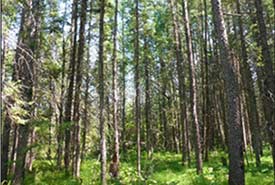
Black spruce bog on Boggy River Mixedwoods property (Photo by NCC)
The Boggy River Mixedwoods property is a 17-hectare (42-acre) property in the East Braintree area of eastern Manitoba. The property consists of two parcels, separated by City of Winnipeg lands containing the Greater Winnipeg Water District railway and aqueduct. This aqueduct is used to supply drinking water to Winnipeg.
The north parcel of the property consists of eastern deciduous riparian forests that border the Boggy River, and are connected to several shallow riparian marshes. Riparian forests provide rivers like the Boggy River with a protective buffer to maintain water quality, and supplies them with coarse woody debris, which riparian species, including fish that live in the river, depend on.
The maintenance of intact and healthy riparian forests may be critical for the success of the nationally and provincially threatened carmine shiner, a fish species that is limited to a handful of watercourses in Canada, including the Birch River, a tributary of the Boggy River.
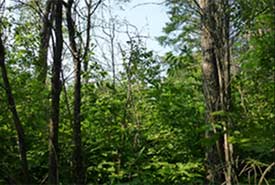
Mixedwood forest on Boggy River Mixedwoods property (Photo by NCC)
The south parcel is a diverse mixture of black ash- and black spruce-dominated swamp, upland mixedwood forest and marsh. Black ash has recently been designated as threatened nationally due to the prevalence of invasive emerald ash borer beetles.
One of my favourite spots on the Boggy River Mixedwoods property is the edge of the riparian forest, where it opens up to reveal the Boggy River. To access it, you have to walk through the former yard site of the Pielou family, where you can see remnants, including the log barn and house as well as the original log cabin, of their past.
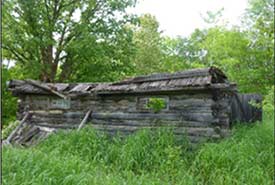
Remnants of the log barn (Photo by NCC)
I gained a real appreciation for the Pielou family’s history and connectedness to the property with the assistance of Barbara and her aunt Maude’s family writeup in the Pioneer History of Glenn, East Braintree and McMunn history book.
Barbara’s grandparents, Edward and Barbara Pielou, along with their six children, settled on the property in 1918, as free land was being offered along the Greater Winnipeg Water District’s aqueduct route. According to Barbara, life was hard on the homestead, and there were many years where the Pielou family depended on hunting and fishing to survive. To feed their family of eight, the Pielou family also had a big garden, a cow and some chickens. Part of the property was cleared to grow hay and grain crops for the animals. Barbara remembers her mom saying many times “that land was never meant to be farmed — it should be returned to nature!”
As Maude wrote, the Pielou family always had an appreciation for nature. The property afforded them so much to learn about the animals, birds, butterflies and plants. As soon as they saved up a little money, they bought books on birds and flowers.
The last surviving member of the original Pielou homesteaders left the property in the late 1980s. Around that time, Barbara was gifted the property by one of her aunts, and decided that when that generation was gone that she would look into “giving it back to nature.” As Maude wrote, “during the seventy years in which the Pielou family lived in the East Braintree area, the name stood for integrity. That is the best monument that a man can have, and the finest heritage that he can leave for his children.”
By setting aside this land, Barbara is paying tribute to the Pielou family’s love of nature, as well as their long history in the East Braintree area. When asked why they chose NCC as the recipient of their land donation, Barbara deferred to her brother, Ian Morrison, who started the donation process. “The Nature Conservancy of Canada protects key areas to ensure the continuation of species within these areas,” says Ian. “We must protect the natural world or we will cease to exist.”
Because of generous gifts like Barbara’s, NCC has conserved and protected over 71,161 hectares (175,843 acres) across nine natural areas to date. These areas are critical to Manitoba’s biodiversity, providing important habitat for thousands of species of plants and animals, many of which are endangered or at risk.
Thanks to the generous donations of Manitobans and our partners, NCC continues to work to ensure that these special areas and the species that live there will be there for generations to come.
Learn more about donating land or conservation agreements here.


